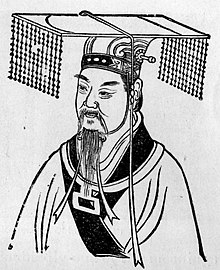Huangdi
Huáng Dì ( Chinese 黃帝 / 黄帝 ) - the Yellow Emperor - is the mythical emperor who is said to have stood at the beginning of Chinese culture.
Life
Huáng Dì belongs to the group of the Chinese original emperors, belongs to the group of five emperors and is said to have been from 2696 to 2598 BC. Have ruled; Originally, however, Huáng Dì is a divine and mythical figure that was historicized only during the Zhou period .
He is one of the most important figures in Chinese mythology . Originally a god of war , who played a minor role in the early traditions, he then turned into the high god and enlightened immortal of Daoism . He is represented as a conqueror, judge, immortal, god of the world mountain Kunlun and the center of the earth.
It is reported from his birth that his mother became pregnant from lightning in the night sky and that Huáng Dì was born after 20 years of pregnancy. He is said to have spoken immediately.
The wife of Huáng Dì is Lei Zu ( 嫘 祖 - "the thunderous woman"); his daughter is Niuba , the drought. There are also reports of a fight between Huáng Dì and his brother Yan Di and a flood unleashed by a monster that defeated Huáng Dì. It is also reported that Huáng Dì made a drum from the skin of the Kui , a mythical being that could generate rain, wind and drought.
An alleged mausoleum of the Yellow Emperor is located in Huangling County, Shaanxi Province. State sacrificial ceremonies are held there up to the present day.
Huangdi Neijing
The Daoists said he had written the book The Medicine of the Yellow Emperor ( 黃帝內經 / 黄帝内经 , Huángdì Nèijīng ). The Huángdì Nèijīng contained the knowledge of acupuncture , acupressure and other areas of traditional Chinese medicine . This work comprises a collection of 81 treatises which are summarized in two books - the Su Wen - questions of an organic and fundamental nature - and the Ling Shu - "Divine pivot", with more technical aspects of acupuncture. The former contains dialogues between the Yellow Emperor and the scholars of his court, in which he explains questions about physiology , morphology , pathology , diagnosis and disease prevention , which was the priority for ancient Chinese medicine . The Ling Shu describes the clinical application of acupuncture and moxibustion , as well as the location of the acupuncture points and the meridians.
In the main work, ideas from both Daoism and Confucianism can be found. Today the book is considered a compilation from around 300 BC. Chr.
literature
- Anne Birell: Chinese Mythology. An introduction . Johns Hopkins University Press, Baltimore MD u. a. 1993, ISBN 0-8018-4595-5 .
- Muhammad WGA Schmidt (Hrsg./Übers.): The Yellow Emperor's classic on internal medicine . Multimedia study and research tool on DVD. 2nd Edition. Viademica-Verlag, Berlin 2008, ISBN 978-3-937494-00-5 (also available as a print medium (book in 3 volumes), ISBN 978-3-937494-00-5 ).
- Muhammad WGA Schmidt: The Medicine of the Yellow Emperor. Concepts and therapies for the body and mind in traditional Chinese medicine . Viademica-Verlag, Berlin 2008, ISBN 978-3-937494-48-7 .
Web links
- Literature by and about Huangdi in the catalog of the German National Library
- Material-rich treatise on Huangdi - English
Individual evidence
- ↑ Horst Kremling : On the development of clinical diagnostics. In: Würzburger medical history reports 23, 2004, pp. 233–261; here: p. 234.
| predecessor | Office | successor |
|---|---|---|
| Shennong |
Mythical Emperor of China 2674-2575 BC Chr. |
Shaohao |
